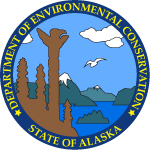| Action Date |
Action |
Description |
DEC Staff |
| 5/9/2001 |
Site Characterization Workplan Approved |
Work plan approved for site characterization as submitted. File update by Pam Clemens 2-15-08. |
Renee Evans |
| 6/22/2006 |
Site Added to Database |
Therminol Spill. Benzene, GRO, DRO, and Total BTEX above surface and ground water cleanup levels. |
Bill Petrik |
| 6/22/2006 |
GIS Position Updated |
Used Figure 1, "CGF Therminol Spill Site, Site Location Map" and Figure 2, "CGF Therminol Spill Site, Site Map" from the Oasis Environmental "CGF Therminol Spill Site, 2005 Annual Water Monitoring Report, Eastern Operating Area, Prudhoe Bay Unit" dated 1/13/06, received by the department 3/3/06 and TopoZone Pro in conjunction BP Exploration (Alaska) Inc. maps "Aerial Photo Mosaic, Colville to Canning River, July 1998, Prepared by AeroMap U.S., Anchorage AK" and "Kogru to Canning, October 2000". Used a 1:24,000 Scale USGS Topo Base Map, Large Map Size, at 1:24,000 Scale. Low confidence in the accuracy of the coordinates. Suggest taking GPS reading to improve accuracy. |
Bill Petrik |
| 6/22/2006 |
Update or Other Action |
File number issued 300.38.254 this will combine 300.38.175 and 300.38.176. |
Aggie Blandford |
| 6/25/2006 |
Site Characterization Report Approved |
Received 2005 Annual Monitoring Report. 1995 spill occurred at the flare pit. Therminol, a heat transfer fluid, was the source of a leak from the flare pit berm into the surrounding tundra. The berm was replaced and a liner installed in 1996 or 1997, which was reportedly damaged during later operations. TAH and TAqH exceeded AWQS in 1999 and 2000. Flare pit dewatered in subsequent years. Thermosiphons were determined to be not operating, allowing a thaw bulb to form below the flare pit and contaminants to migrate out into the tundra. In 2002, six monitoring wells installed. Free product was observed in one well on two occasions and TAH and TAqH were exceeded in MW01, MW03, MW04, and MW06. In 2003, free product was observed in MW03. Hydrocarbon concentrations in surface water were generally lower than in previous years. In 2004, the flare pit was dewatered again and MW03 still contained free product. Thermosiphons had previously been repaired and hydrocarbon concentrations were significantly lower since the repairs were completed and since the pit was dewatered. In 2005, hydrocarbon concentrations in surface water were generally lower than historical samples. Report recommends continued monitoring, continued flare pi\t dewatering, and continued maintenance of thermosiphons. |
Bill O'Connell |
| 7/19/2007 |
Site Characterization Workplan Approved |
Received 2007 water quality monitoring work plan. Samples will be collected from 2 monitoring wells and 6 surface water locations, and product thickness will be measured in MW03, which will also be sampled if no product is present. |
Bill O'Connell |
| 6/17/2008 |
Site Characterization Report Approved |
Received 2007 Monitoring Report for CGF Therminol spill and request for Conditional Closure. Two active-layer water samples were collected from monitoring wells and four surface water samples were collected from established monitoring locations. DRO, GRO, and benzene were detected in one active-layer water sample at 3.56 mg/l, 6.0 mg/l, and 1.03 mg/l respectively. DRO was detected in one surface water sample at 0.613 mg/l however the chromatogram from the sample did not show a distinct diesel pattern and may be due to heavily weathered product or biogenic interference. No other analytes were detected in surface water |
Bill O'Connell |
| 7/11/2008 |
Update or Other Action |
Response to conditional closure request sent to BPXA. Due to conditions at the site, ADEC cannot conditionally close the site at this time however a reduced monitoring schedule in accordance with the 2007 Report is approved. |
Bill O'Connell |
| 7/8/2009 |
Document, Report, or Work plan Review - other |
Reviewed 2009 Work Plan for CGF Therminol Spill Site. Product thickness will be measured in well MW03 and a sample will be collected if product is absent from the well. Active layer water samples will also be collected from MW01 and MW04. Surface water samples will be collected from 6 sampling locations. |
Bill O'Connell |
| 2/2/2011 |
Document, Report, or Work plan Review - other |
Reviewed 2009 Monitoring Report. Six surface water samples and three active layer water samples were collected. Annual dewatering of the flare pit since 2002 and the recharging of the thermosiphons in this area were intended to stem the flow of contaminants through the flare pit berm. In surface water samples, GRO, BTEX, and PAHs were not detected. DRO was detected in two samples at 0.47 mg/l and 0.414 mg/l. No sheen was produced when sediment was disturbed after sampling. These results are in contrast to previous sampling efforts at the site, when AWQS were exceeded and sheen was generated in several location. In active layer water samples, contaminants were detected above cleanup levels in each of the three wells that were sampled. Free product was not present in well MW-03, however this well contained the highest concentrations of contaminants, with DRO detected at 4.32 mg/l, GRO at 37.8 mg/l, and benzene at 7.11 mg/l. Next monitoring effort is planned for 2011. |
Bill O'Connell |
| 7/20/2011 |
Document, Report, or Work plan Review - other |
Reviewed 2011 work plan for CGF Therminol Spill Site. Porewater samples will be collected from 2 monitoring wells, MW03 will be checked for free product and sampled if none is present, and surface water samples will be collected from 6 established monitoring locations. Porewater samples will be analyzed for DRO, GRO, and BTEX. Surface water samples will be analyzed for BTEX, with two of the samples also analyzed for DRO, GRO, and PAHs |
Bill O'Connell |
| 7/31/2012 |
Document, Report, or Work plan Review - other |
Reviewed 2012 work plan for water quality monitoring at CGF therminol Spill Site. Product thickness will be measured at well MW03 and a sample collected if product is absent. |
Bill O'Connell |
| 8/17/2012 |
Document, Report, or Work plan Review - other |
Reviewed 2011 monitoring report for CGF Therminol spill site. Surface water samples were collected from two locations as the other locations scheduled for sampling were dry. Pore water samples were collected from 2 wells. Free product was encountered in MW-03, however its thickness was not measured. Surface water samples did not contain contaminants above AWQS. Pore water samples contained DRO up to 1.82 mg/l and benzene up to 0.189 mg/l. |
Bill O'Connell |
| 6/19/2013 |
Document, Report, or Work plan Review - other |
Date of receipt of 2012 Monitoring Report which was reviewed 9/25/13. Free product (0.14 feet) was detected in MW-03. No analytical samples were collected but depth to water was measured at three wells. |
Keather McLoone |
| 8/8/2013 |
Document, Report, or Work plan Review - other |
Reviewed CGF Therminol Spill Site water quality monitoring work plan. Pad pore water samples will be collected from two to three wells, depending on the presence of free product in MW03. Surface water samples will be collected from six established surface water monitoring locations, and field observations will be recorded. |
Bill O'Connell |
| 3/28/2014 |
Document, Report, or Work plan Review - other |
Date of receipt of 2013 RCRA Annual Report. Appendix A addresses work conducted at SWMU Project Groups to Fulfill Other Obligations and includes documenting the type of work performed during the summer of 2013 at this site. Results are to be reported elsewhere. In 2013, after verifying that the NGL flare pit was dewatered, samples were collected from two monitoring wells and product thickness measured at MW03. Well samples were analyzed for GRO, DRO, and BTEX. Six surface water locations were sampled and analyzed for the same constituents as the monitoring wells plus PAH. |
Keather McLoone |
| 4/14/2014 |
Document, Report, or Work plan Review - other |
Date of receipt of 2013 Monitoring report. Activities included surface water sample and active-layer sample collection. MW-03 product thickness is about 0.49 feet according to Table 2. A Mann-Kendall trend analysis was performed on the active-layer results. Six surface water locations were sampled for BTEX, GRO, DRO and PAHs. Only one location, SW09, exceeded TAH or TAqH. This location also exceeded AWQS for benzene and produced a slight sheen upon disturbance. Two well (active-layer) locations were sampled for GRO, DRO, and BTEX. One location, MW04, exceeded Table C levels for GRO and DRO and exceeded AWQS for ethylbenzene. This site has biennial monitoring, so next event will be in 2015. |
Keather McLoone |
| 7/29/2015 |
Document, Report, or Work plan Review - other |
Date on Transmittal of the 2015 Contaminated Sites Water Quality Monitoring Workplan for D Pad, Service City, COTU North, COTU South, BOC Bulk Fuel Facility Utilidor, DSM Shop, PBOC Generator, MCC Fuel Island. As of 10/15/15 an approval letter hadn't been sent because ERM/BP had not yet provided the 2014 COTU South report although it has been reportedly just about ready for 2 months. |
Keather McLoone |
| 7/25/2016 |
Document, Report, or Work plan Review - other |
Reviewed the CGF Therminol® Spill Site 2015 Contaminated Sites Monitoring Report, dated July 2016, for the BPX Central Gas Facility Therminol Spill site. Activities described in the report mainly consisted of biennial pad-pore water monitoring of Wells MW-01, MW-03, and MW-04, and six surface water locations (SW-01 through SW-03, SW-05, SW-08, and SW-09). After samples were collected from the surface water sample locations, shovel-sheen testing was performed to determine if a sheen could be produced; no sheens were observed at any surface water locations. Well MW-03 was not sampled because 0.04 feet of free product was present in the well.
The samples collected from Monitoring Well MW-04 exhibited a concentration of GRO at 9.3 mg/l, DRO at 1.7 mg/l, benzene at 1.7 mg/l, toluene at 1.4 mg/l, and TAH at 3.745, all of which exceed the Table C groundwater cleanup levels and/or Alaska Water Quality Standards (AWQS), as applicable. The sample collected from MW-01 exhibited a concentration of benzene at 0.0066 mg/l, however, did not exceed the AWQS for TAH. None of the surface water samples exhibited contaminants that exceed the AWQS or ADECs Table C groundwater cleanup levels.
Recommendations provided in the report included continued product monitoring and sampling of Wells MW-01, MW-03, and MW-04, and the six surface water locations (SW-01 through SW-03, SW-05, SW-08, and SW-09). However, instead of performing the monitoring biennially, it was recommended that the sampling frequency be changed to once every five years; or in the event that the central gas facility is not operating due to a plant turnaround event, or the natural gas liquids flare and the emergency flare are unneeded. In a letter dated July 25, 2016 ADEC requested a revised report and indicated that biennial monitoring will be required until the free product in Well MW-03 is no longer present, or the department determines that the remaining product has been removed to the extent practicable and a stable and decreasing trend is anticipated. |
Joshua Barsis |
| 6/7/2017 |
Document, Report, or Work plan Review - other |
Reviewed the 2017 Biennial Contaminated Sites Monitoring Work Plan, dated June 2017. This work plan was prepared for the following three Contaminated Sites: 300.38.229; 300.38.254, and 300.38.045. Proposed activities generally consist of pad porewater and surface water sampling. |
Joshua Barsis |
| 4/12/2018 |
Document, Report, or Work plan Review - other |
Review of the 2017 Inspection Report and 2018 Monitoring Work Plan, dated March 30, 2018, for the BPX Central Gas Facility Therminol® Spill site. Planned 2017 activities were not completed because of safety concerns over an active flare. Proposed activities for the 2018 field season generally include sampling of Wells MW-01, MW-04, and MW-03 (provided liquid phase hydrocarbons are not present). Additionally, surface water samples will be collected from six locations (SW-01, SW-02, SW-03, SW-05, SW-08, and SW-09). |
Joshua Barsis |
| 5/21/2019 |
Document, Report, or Work plan Review - other |
Review of the 2018 Inspection Report and 2019 Monitoring Work Plan, dated May 7, 2019, for the BPX Central Gas Facility Therminol® Spill site. Planned 2018 activities were not completed because of safety concerns over an active flare. Proposed activities were revised for the 2019 field season to include: sampling of Wells MW-01, MW-04, and MW-03 (provided liquid phase hydrocarbons are not present); visual and physical sheen inspections along the flare pit shoreline; and collection of up to one surface water sample in the area exhibiting the heaviest sheen. |
Joshua Barsis |
| 5/20/2020 |
Document, Report, or Work plan Review - other |
Received 2019 data report for field inspection. |
Andrea Carlson |




